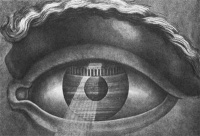Visual system
From The Art and Popular Culture Encyclopedia
|
Related e |
|
Featured: |
The visual system is the part of the central nervous system which enables organisms to process visual detail, as well as enabling several non-image forming photoresponse functions. It interprets information from visible light to build a representation of the surrounding world. The visual system accomplishes a number of complex tasks, including the reception of light and the formation of monocular representations; the construction of a binocular perception from a pair of two dimensional projections; the identification and categorization of visual objects; assessing distances to and between objects; and guiding body movements in relation to visual objects. The psychological manifestation of visual information is known as visual perception, a lack of which is called blindness. Non-image forming visual functions, independent of visual perception, include the pupillary light reflex (PLR) and circadian photoentrainment.
See also
- Echolocation
- Computer vision
- Helmholtz–Kohlrausch effect - how color balance affects vision
- Memory-prediction framework
- Visual perception
- Visual modularity


